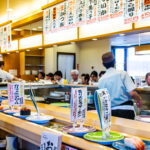This post may contain affiliate links. Please read our disclosure policy.
Conveyor belt sushi, or kaiten sushi, is one of the most fun and affordable ways to enjoy sushi in Japan.

What is Conveyor Belt Sushi?
Kaiten sushi restaurants serve small plates of sushi that travel around the dining area on a conveyor belt. We love that you can pick what looks good or order directly from a touchscreen menu. Special orders usually arrive on a separate tray or delivery lane, so you know they’re fresh and just for you.
At newer restaurants, each plate has a chip or barcode underneath, making checkout quick and easy. Staff scan the plates to calculate your total.
Seating at Kaiten Sushi Restaurants

Most restaurants offer both counter seating and booths for groups of four to six. Families usually prefer the booths. On weekends, expect crowds and possible wait times of over an hour. Visiting earlier in the day or on a weekday makes the experience smoother.
How to Eat at a Conveyor Belt Sushi Restaurant

Once seated, you’ll find chopsticks, soy sauce, and green tea powder at your table. Add a spoonful of tea powder to your cup, fill it with hot water, and you’ve got a simple cup of green tea.
If you don’t see your favorite sushi on the belt, use the digital screen. Many have English menus and let you order sushi, side dishes, drinks, and desserts. Some even let you skip the wasabi, request less rice, or order smaller cuts for kids.
How Much Does It Cost?

Prices are set by plate color or design. Common price points range from ¥250 to ¥900 per plate, with premium items costing more. Look for the price guide displayed in the restaurant.
When you’re ready to leave, press the call button. A staff member will scan your plates in seconds and bring your bill.
Our Favorite Conveyor Belt Sushi Chains
There are hundreds of kaiten sushi restaurants across Japan, but a few stand out to us:
- Toriton – Originally from Hokkaido, this chain has two branches in Tokyo and is often ranked among Japan’s top sushi spots. The fish is consistently fresh and delicious.
- Maimon Sushi – A chain from Kanazawa specializing in seafood from the Sea of Japan, including nodoguro (blackthroat seaperch). Locations in the Kanto region make it easy to try.
Is Conveyor Belt Sushi Worth Trying in Japan?

Conveyor belt sushi is a fun, casual way to enjoy Japanese seafood. It’s easy to understand, family-friendly, and surprisingly good quality for the price. For us, it’s a must-do on every Japan trip, whether for a quick lunch or a fun dinner with the kids.
More Food Adventures in Japan
If you’re looking for more food adventures in Japan, you might also enjoy:
- Omicho Market in Kanazawa – A lively seafood market with fresh sushi stalls.
- Hakodate Morning Market in Hokkaido – Famous for squid fishing and donburi bowls.
- Nakamise Shopping Street in Asakusa – Traditional snacks and souvenirs leading to Tokyo’s oldest temple.
- Dotonbori in Osaka – A vibrant street known for takoyaki, okonomiyaki, and neon lights.




